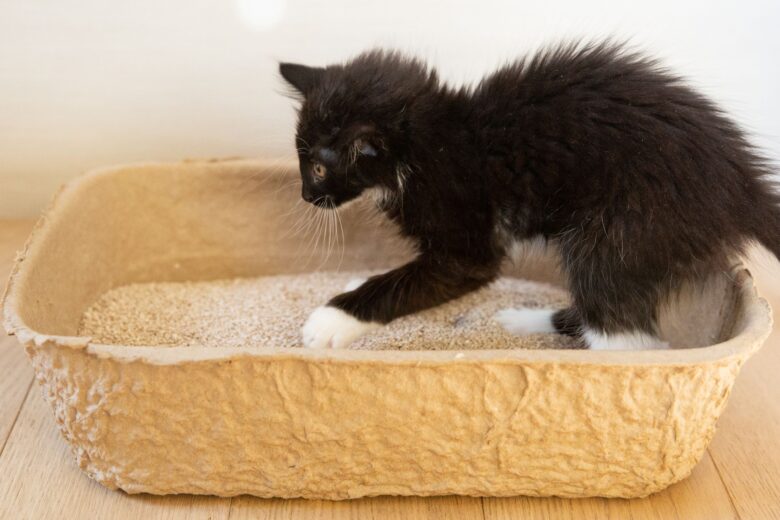It’s fun when you bring a kitten into your home, but you also have to teach him things like using the litter box. Teaching your kitten to use the litter box is an important part of caring for your pet and keeping your home clean. This guide will help you through the entire process.
Find Out How Your Kitten Behaves:
Kittens naturally seek out soft, sandy places to go to the toilet, making it very easy for them to learn to use the litter box. The process will go smoother if you understand how they feel and provide them with the right conditions.
Step 1: Choose a Container
Choose a litter box that is the right size for your cat. It should be low enough for them to get into and large enough for them to turn around smoothly. As your kitten grows, you may need to purchase a larger box.
Step 2: Choose the Right Litter
Due to their elimination behaviour, kittens prefer fine-grained litter, as it feels like natural soil. Kittens under four months of age should not use clumping litter because they can swallow it and become sick.
Step 3: Placement of the Litter Box
Place the litter box in a quiet and easily accessible place so that your kitten has privacy nearby. Cats like to have separate areas for eating and excreting, so avoid placing them near food and water.
Step 4: Let Your Kitten Use the Litter Box
Once you bring your kitten home, teach her how to use the litter box. Place them in a box and scratch the nest with their front paws. But if they want to leave, don’t let them stay.
Step 5: Look for Signs
Check if your kitten is sniffing, crouching or walking to let you know he needs to go. If you see these signs, gently place them in the litter box to keep them behaving.
Step 6: Keep the Litter Box Clean
Cats are clean animals and like to go to the toilet in clean places. Clean the litter boxes and replace the litter at least once a day. If the litter box is dirty, your kitten may not want to use it.
Step 7: Stay Away from Negative Reinforcement
If your baby has an accident outside the litter box, don’t scold or punish him. This can make you anxious and make training more difficult. Instead, clean the area thoroughly to remove the odour and prevent the mistake from happening again.
Step 8: Stay Steady and Patient
Cats learn at their own pace, so be patient and keep doing what you’re doing. To get your kitten to use the litter box, gently guide her there every day, especially after meals and naps.
How to Solve Common Problems:
Doesn’t Want to Use the Litter Box: If your baby doesn’t want to use the litter box, check the type of litter, the location of the litter box, and how clean it is. Try placing the litter box in different locations and with different types of litter to see what your kitten likes best.
Multiple Cats in the House: If you have more than one cat, give each cat its own litter box so they don’t have to compete with each other or feel stressed. In general, each cat should have more than one litter box.
Health Issues: Not using the litter box can sometimes be a sign of a health problem. If your kitten suddenly stops using the litter box, take her to the vet to make sure there are no health problems.
Conclusion:
To teach your kitten how to use the litter box, you need to understand his needs and behaviour, be patient and pay attention. By following this step-by-step guide, you can provide your kitten with a safe and comfortable living environment that supports his natural instincts. This will keep your house clean and keep you and your new furry friend happy.
In summary, litter training is an important part of caring for a kitten. It requires understanding their natural behaviour patterns and providing a good place to learn. If you are patient and persistent and use the right methods, you can train your kitten. This makes your home calmer and promotes a bond with your pet.
FAQs:
1. When should I start taking my kitten to the outdoor bathroom?
You should teach your kitten to use the litter box as soon as you bring him home, usually when he is 8 weeks old. You can teach your kitten how to use the litter box at an early age.
2. If I have more than one cat, how many litter boxes do I need?
In general, each cat should have its own litter box, plus an extra litter box. This means that if you have two cats, you will need three litter boxes. This prevents cats from competing with each other and ensures that every cat has a clean litter box.
3. How do I choose the best cat litter for my kitten?
Non-clumping, fine-grained cat litter is best for cats because it’s easier for paws to reach and they’re less likely to get sick if they eat it. Kittens under four months of age should not use clumping litter, as it can cause digestive problems if ingested.
4. Why doesn’t my cat use the litter box?
There are many reasons for this, such as the type of waste, the cleanliness of the litter box, the location of the litter box, or health problems. Place the litter box in a quiet, clean place and make sure it is filled with litter that your kitten likes. If the problem does not go away, you should consult your doctor to rule out a medical problem.
5. How often are litter boxes cleaned?
Scoop the litter box at least once a day, clean it thoroughly and change the litter regularly, usually once a week. It keeps your kitten’s box fresh and stops odours and bacterial growth



